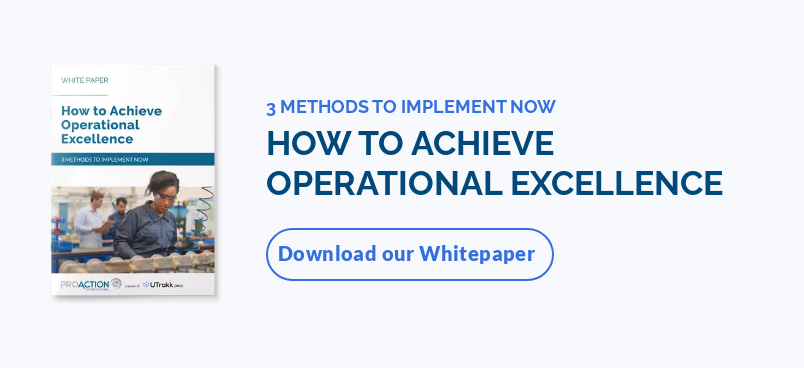What is Lean methodology?
Born of the Toyota production system, this methodology is an integral part of Lean thinking. It is defined as a systematic approach to continuously improve processes by identifying and eliminating inefficiencies. This includes reducing lead times, improving quality, and optimizing resources.
Lean teams focus on continuous improvement and waste reduction, ensuring that every step in the process adds value and enhances efficiency.
The 5 principles of Lean
The fundamental principles of Lean are:
- Define value from the customer's point of view.
- Map the customer value chain to identify all unnecessary steps.
- Establish a continuous production flow.
- Create a pull system where production is based on actual demand.
- Cultivate continuous improvement.
Benefits of Lean
- Reduced operating costs
- Improved product quality
- Acceleration of production lead times
- Increased customer satisfaction
- Greater flexibility to respond to fluctuations in demand
Several Lean techniques, such as 5S, Kaizen, Value Stream Mapping (VSM), or Just-in-Time, are inspired by Lean Manufacturing principles.
What is Agile methodology?
Agile methodology is an approach to project management and product development that emphasizes adaptability, collaboration, and customer satisfaction through short, repeatable development cycles. Its primary objective is to deliver high-quality products quickly while being responsive to changes and continuously improving the product through regular customer feedback.
Cross-functional teams play a crucial role in the Agile development process. They bring together diverse skills and perspectives to solve problems collaboratively and deliver high-quality products.
Originally conceived for software development (Agile software development), the methodology is now used by agile teams in various sectors, including manufacturing.
The 12 principles of Agile
The 12 principles of this approach, as defined in the Agile Manifesto, are:
- Prioritize customer satisfaction through the rapid and continuous delivery of useful products.
- Welcome changes in requirements, even late in development.
- Frequently deliver operational versions of the product.
- Collaborate closely with all stakeholders.
- Motivate individuals and give them the tools they need to succeed.
- Encourage face-to-face communication.
- Measure progress through operational product functionality.
- Maintain a sustainable work pace.
- Promote technical excellence and optimal design.
- Simplify (maximize the amount of unfinished work).
- Encourage self-organized teams.
- Reflect regularly to improve and adjust behavior accordingly.
Benefits of the Agile method
- Greater flexibility and adaptability
- Improved communication and collaboration
- Faster product delivery
- Reduced risk thanks to frequent iterations
- Increased customer satisfaction thanks to continuous feedback
There are several Agile methods, including various frameworks and practices following the principles of the Agile Manifesto, such as Scrum, Kanban, or XP (Extreme Programming).
The differences between the two methods
Although Lean and Agile are both focused on improving process efficiency and adaptability, their approach differs.

How Lean and Agile methods complement each other
The Scaled Agile Framework
The Scaled Agile Framework (SAFe) combines Agile and Lean principles to create a structure that can be applied on a large scale in manufacturing companies. SAFe clearly defines roles and responsibilities at every level of the organization, facilitating team coordination and alignment.
SAFe is based on 4 core values:
- Alignment: Ensures that teams work towards common goals, aligned with the company's strategic vision.
- Integrated quality: Ensures that every step of the process maintains a high level of quality to avoid costly product defects.
- Transparency: Promotes visibility at all levels to foster trust and enable informed decision-making.
- Program execution: Focuses efforts on delivering value through Program Increments (PI).
To these values can be added a fifth: Lean-Agile leadership, i.e. leaders trained to support and encourage Lean-Agile practices.
SAFe application example
A large manufacturing company develops a complex new product that requires coordination between several engineering, production, marketing, and sales teams.
Implementation
- All teams are trained in Lean-Agile principles and SAFe practices.
- Agile Release Trains (ARTs) are set up to synchronize work between different teams.
- PI Planning is organized to define the objectives and deliverables of the next PI.
- Agile teams work in synchronized sprints, delivering incremental functionality at the end of each sprint.
- At the end of each IP, a retrospective is held to identify possible improvements and adjust processes.
Results
- Better alignment: Teams work consistently towards common goals.
- Shorter development times: Short, iterative development cycles enable rapid adjustments and accelerated delivery.
- Improved quality: Continuous integration and regular testing ensure the high quality of the final product.
Lean-Agile thinking
While Lean methodology focuses primarily on eliminating waste and optimizing production processes to maximize efficiency and added value, Lean-Agile integrates Lean principles with Agile practices, adding a dimension of adaptability and responsiveness to change. It creates a flexible, efficient, and value-focused working environment.
By adopting a Lean-Agile approach, companies can not only optimize their processes, but also respond rapidly to evolving customer and market needs.
Here's how Lean and Agile principles work together:
Optimization and adaptability
- Use Lean principles to optimize production processes and reduce waste.
- Apply Agile methodologies to rapidly adapt processes in response to changes and customer feedback.
Workflow and iterative delivery
- Adopt a continuous workflow to ensure smooth, uninterrupted production.
- Use iterative cycles to deliver frequent product increments and obtain constant feedback.
Collaboration and continuous improvement
- Encourage continuous improvement to constantly identify opportunities for optimization.
- Promote a culture of open collaboration to improve communication between teams and stakeholders.
Example of Lean-Agile thinking
A manufacturing company wants to improve its product development processes while remaining flexible to changing customer demands.
Implementation
- Value chain mapping to identify and eliminate waste and optimize processes. Adoption of Lean practices such as Just-In-Time to reduce inventory and lead times.
- Product development will be conducted in two-week sprints, with incremental deliveries at the end of each sprint. Customer feedback will be gathered to adjust and improve the product.
- Regular retrospectives to identify areas for improvement and implement corrective actions. Encourage employees to come up with ideas for improvements.
Results
- Reduced lead times: Optimization of processes using Lean principles, enabling faster production.
- Increased flexibility: Ability to quickly adjust plans and processes in response to customer feedback thanks to Agile methodologies.
- Employee and customer satisfaction: Improved employee engagement thanks to a culture of respect and collaboration and customer satisfaction thanks to high-quality products that meet their needs.
Note that both methods require regularly updating processes to remain effective and relevant.
Improve your efficiency and agility with UTrakk
UTrakk is a complete Daily Management System (DMS) that supports Lean and Agile methods through multiple functionalities, such as dashboards, digitalized floor tours (Gemba Walks), actions and opportunities, daily meetings, and more.
UTrakk support for Lean
- Immediate response to problems: The solution enables real-time detection of variances or inefficiencies in production processes, with dashboards and digital Gemba Walk checklists. Corrective actions are quickly implemented, minimizing downtime and ensuring smooth operations.
- Rapid problem resolution: UTrakk DMS supports problem-solving methods such as PDCA and the 5 Whys, to prevent problems from happening again. It also facilitates the planning of daily meetings and committees, encouraging problem analysis and action prioritization and monitoring.
- Standardized processes: UTrakk includes a Knowledge Center that helps document and share standardized work instructions, processes, and procedures, minimizing confusion (and waste of time) and ensuring all employees comply with set standards.
- Continuous improvement: The DMS solution provides a platform for assessing performance and discussing improvements on a regular basis. For example, during dedicated committees, teams can analyze data, identify inefficiencies, and implement incremental changes to improve processes.
- Performance tracking: UTrakk dashboards offer instant visualization of key performance indicators through simple diagrams and standardized colors. They enable real-time data monitoring and analysis to quickly correct variances, adjust processes, and maintain optimal performance.
UTrakk support for Agile
- Increased visibility: UTrakk DMS includes a Project Tracking module and action lists that provide clear visibility on current tasks, their progress, due dates, and owner. This transparency helps to identify actions and projects encountering obstacles, so that they can be addressed quickly and stay on track.
- Continuous feedback loop: Daily rituals such as floor tours, audits, meetings, and committees facilitate regular checks and updates. This ensures that feedback is constantly collected and integrated, promoting an iterative approach that leads to improvements and adjustments.
- Task prioritization: The solution helps managers prioritize tasks and closely track them until completion. Focusing on tasks and projects that add value ensures teams are always working on the most important things.
- Communication and collaboration: UTrakk offers communication tools – daily meetings, floor tours, etc. – that encourage frequent conversation and collaboration between members of different departments. This promotes cross-functional teamwork, while speeding up decision-making and problem-solving.
- Real-time tracking: With insightful dashboards, the DMS tracks performance indicators and progress in real time, enabling organizations to quickly address changes. This ability to pivot or adjust strategies according to current data reinforces companies’ adaptability and agility towards market fluctuations.
Boost operational performance by combining Lean and Agile
The synergy between Lean and Agile methodologies offers manufacturing companies a royal road to operational excellence. By eliminating inefficiencies through Lean principles and adopting Agile flexibility and responsiveness, the organization can not only optimize its internal processes but also adapt quickly to market changes and customer demands and remain competitive.
The use of tools like UTrakk makes this integrated vision a reality, providing the means to monitor, analyze, and continuously improve performance at all levels.
Combining the strengths of Lean and Agile approaches positions us to meet today's challenges and seize future opportunities with greater ease and efficiency.










